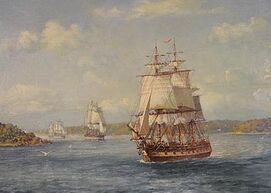In March, our speaker Adele Thompson told us of the era of the 1788 First Fleet, and some details of her ancestor, Matthew Everingham who was one of the First Fleeters.
In 1787, 12 small ships left Britain for Australia. The largest was “Sirius”, the flagship and “Supply” was the smallest. This convoy travelled 15,000 miles to an unknown land, and to unknown conditions in it.
A total of 1350 people were in the 12 vessels. Convicts were about 775; there were 28 marines, their wives and children, 7 doctors and many officials and crew of the ships.
Captain Arthur Phillip, renowned as a compassionate man for the times, aboard “Supply”, the fastest ship lead the Fleet, which departed “off into the unknown” on May 13th, 1787. The first stop was Tenerife in the Canary Islands - then the ships put in at Rio de Janeiro, in Brazil where they took on water and at Cape Town, horses, pigs, cattle and poultry were loaded.
On the 18th of January 1788, they* arrived at Botany Bay, which was soon found unsatisfactory, so Phillip decided that Port Jackson was a better site. So on January 26th, 1788 the fleet sailed into the harbour and the First Fleeters set up their life in Sydney.
The first years were very precarious. Food was scarce and supplies were vital and husbanded carefully. The Second Fleet, bringing further food and necessities was eagerly awaited and arrived in 1790, after a disastrous voyage, many convicts dying on the way and others on arrival.
Matthew Everingham, Adele’s ancestor had been sentenced to transportation for seven years, for the theft of 2 books in London. In the later eighteenth century the enclosure acts had a major effect on the society of the time. People left the land, flooded into towns to work in cotton mills and other industries, crime flourished, and thousands were sentenced to hanging and transportation for comparatively minor offences.
Old vessels, called hulks, were converted into floating gaols - these were hotbeds of criminality, illnesses such as gaol fever carried off many before they could be transported to Australia.
After completion of their sentence, without offending again in the colony, convicts were granted land. Married men received 50 acres ad single men 30 acres.
Matthew Everingham, like many other convicts, married a convict girl and took up land in the Hawkesbury area. He tried to cross the Blue Mountains in 1795, long before they were eventually conquered. He became a police constable, and later a baker in the Hawkesbury district. His 10 children and later descendants spread over other parts of Australia and became some of our early settlers.
We thank Adele for her fascinating glimpse into the life of the First Fleeters who made the unpromising country of Australia into their permanent home and set the. scene for the land we know today.
Source: 2008-06 DTHS Newsletter


No comments:
Post a Comment